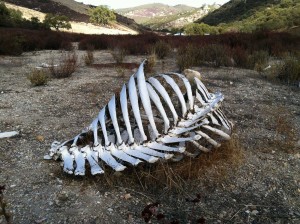Faunal Analysis
Dr. Rubén G. Mendoza, PhD
Description: Drawing on authentic samples of the many faunal or animal bone specimens recovered from the archaeological deposits of Mission Soledad or San Juan Bautista, or other area sites and deposits, students will be introduced to the primary means by which bones are recovered, analyzed, and interpreted for cultural meaning. This lab module will require that you undertake the supervised study and analysis of animal bone for the purposes of (a) identifying individual specimens as per animal species, (b) butchering and cut mark analysis and cultural interpretations, and (c) taphonomy or taphonomic analysis of those conditions that either permitted or hindered the preservation of that sample of bone under analysis.
Considerations: The following methodological considerations and procedural guidelines should be taken into account when embarking on the analysis of the specimens under consideration.
1. You should first form into groups of about three to four team members. Each team member should undertake the completion of one of the following tasks:
(a) Preparation of a detailed technical description of the specimen and or specimens selected for the analysis, including Site Trinomial (CA-MNT-233H or CA-SBN-1H) and Unit Number and Level, size and weight;
(b) Microscopic analysis and description and technical illustration of cut marks or breakage patterns inherent in specimen;
(c) Annotated cultural interpretations based on available lab manuals and Internet site resources; and, (d) Setup and take down of specimens so as to assure that all specimens are removed and replaced to
their original containers and or locations.
2. Having collected the aforementioned data, you will then collectively review the results of your interpretations and propose a hypothetical reconstruction of the environmental conditions and cultural variables that originally resulted in the modification of that bone under analysis, and its deposition, and preservation within the site matrix in question. Please provide an active hypothesis to explain the data, and an alternative, or null hypothesis that may provide a counterpoint to your interpretations.
3. In your analysis, please be prepared to identify variations in the cut marks and what said marks indicate about specific butchering practices and or tools and techniques. Given the theory that Hispanic and Mexican era butchers used cleavers and large knives to hack selections of meat from the animal carcass, thereby producing a rough-cut of meat and broken bones; and latter Anglo American settlers made use of large knives and bone saws for carefully cutting meat selections; please indicate which bones in your sample you believe to have been butchered in the Hispanic era, and which were prepared in latter periods. Of course, this theory hinges on the sheer abundance of cattle during the Hispanic and Mexican periods, and the paucity of “good” beef in the American era when demand was much higher.
4. Having completed with the analysis and interpretations in question, you should now proceed to at least one other sample of bone that differs in type and characteristics from the earlier samples. Please proceed to undertake a limited version of the aforementioned exercise.


